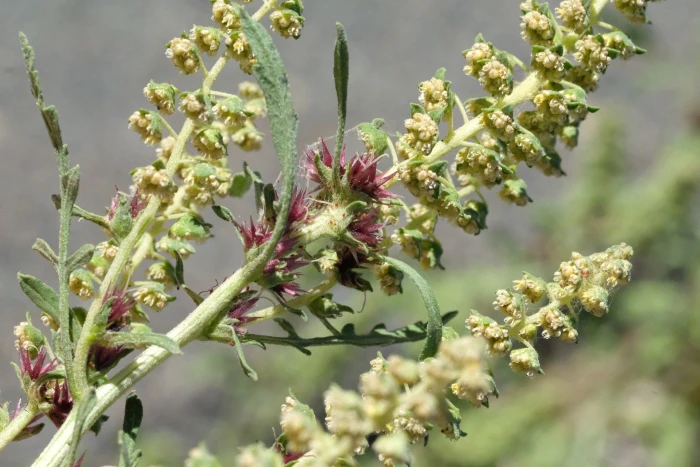Flatspine Bur Ragweed
(Ambrosia acanthicarpa)
Flatspine Bur Ragweed (Ambrosia acanthicarpa)
/
/

Madeleine Claire
CC BY 4.0
Image By:
Madeleine Claire
Recorded By:
Copyright:
CC BY 4.0
Copyright Notice:
Photo by: Madeleine Claire | License Type: CC BY 4.0 | License URL: http://creativecommons.org/licenses/by/4.0/ | Rights Holder: Madeleine Claire | Publisher: iNaturalist | Date Created: 2021-10-14T13:27:46-07:00 |
























Estimated Native Range
Climate Requirements
| • Precipitation | 3" - 55" |
| • High Temp. | 69°F - 110°F |
| • Low Temp. | -10°F - 52°F |
Summary
Ambrosia acanthicarpa, commonly known as flatspine bur ragweed, is an annual herbaceous plant native to arid and semi-arid regions, including grasslands, open prairies, and disturbed sites in the western United States and the Prairie Provinces of Canada. It typically grows in clumps with erect stems that can reach over a meter in height and are covered in bristly hairs. The plant is characterized by its spiny burs that can attach to animals and clothing, aiding in seed dispersal.
Flatspine bur ragweed is valued for its adaptability to poor soil conditions and its ability to thrive in full sun with low water requirements. It is often considered a weed due to its aggressive growth and potential to outcompete native vegetation. In cultivation, it is rarely used due to its invasive nature and the irritation its pollen can cause to those with allergies. However, it can be utilized for soil stabilization in areas where other plants struggle to grow. Gardeners should be cautious when handling this plant due to its spiny burs and should wear gloves to prevent skin irritation.CC BY-SA 4.0
Flatspine bur ragweed is valued for its adaptability to poor soil conditions and its ability to thrive in full sun with low water requirements. It is often considered a weed due to its aggressive growth and potential to outcompete native vegetation. In cultivation, it is rarely used due to its invasive nature and the irritation its pollen can cause to those with allergies. However, it can be utilized for soil stabilization in areas where other plants struggle to grow. Gardeners should be cautious when handling this plant due to its spiny burs and should wear gloves to prevent skin irritation.CC BY-SA 4.0
Plant Description
- Plant Type: Herb
- Height: 0.5-1.5 feet
- Width: 0.5-1.5 feet
- Growth Rate: Moderate
- Flower Color: Green, White, Yellow
- Flowering Season: Spring, Summer, Fall
- Leaf Retention:
Growth Requirements
- Sun: Full Sun
- Water: Low
- Drainage: Medium, Fast
Common Uses
Erosion Control, Low Maintenance
Natural Habitat
Native to arid and semi-arid regions, including grasslands, open prairies, and disturbed sites
Other Names
Common Names: Flatspine Burr Ragweed, Sand Burr, Hooker’s Bur Ragweed, Annual Bur-Sage, Bursage, Bursage Ragweed, Annual Burrweed, Spiny Burr Ragweed
Scientific Names: Ambrosia acanthicarpa, Franseria acanthicarpa, Franseria californica, Franseria hookeriana, Franseria montana, Gaertneria acanthicarpa, Gaertneria hookeriana, Hemixanthidium montanum
GBIF Accepted Name: Ambrosia acanthicarpa